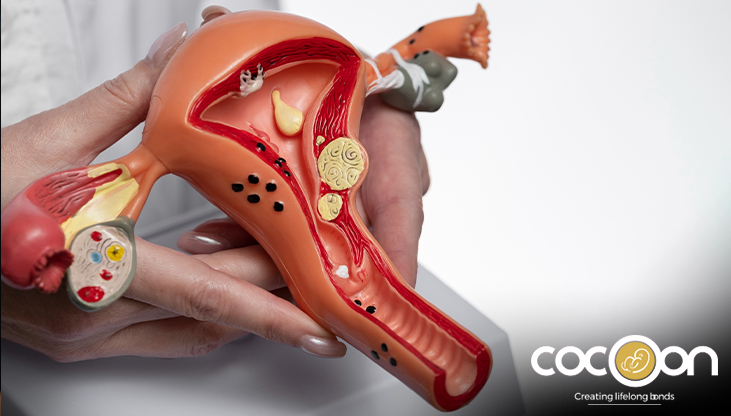A woman's vaginal discharge is a normal and vital aspect of her reproductive health. It aids in vaginal cleansing, infection prevention, and bacterial balance. Hormonal fluctuations throughout the menstrual cycle can cause variations in the volume, hue, and consistency of vaginal discharge. Clear or white discharge that doesn't smell strongly is usually typical and a sign of a healthy vagina.
Some changes in vaginal discharge, however, such as a bad odour, a yellow or green hue, a thick or frothy texture, or itching and discomfort, might be signs of an infection or underlying medical issue. Sexually transmitted infections (STIs), yeast infections, and bacterial vaginosis are among the conditions that can cause irregular or abnormal vaginal discharge and necessitate medical treatment.
To maintain vaginal health, it is essential to recognize the difference between normal and unhealthy vaginal discharge. With this article you can understand types of vaginal discharge, common causes of vaginal discharge , when to be concerned, and efficient methods for managing and preventing possible problems related to vaginal discharge. Reproductive health may be enhanced and issues can be prevented by knowing when to consult a doctor.
What is the Role and Importance of Healthy Vaginal Discharge?
Vaginal discharge is normally clear or white in colour. Within the female reproductive system, it serves as a crucial cleansing function. The substance you occasionally see in your underpants is a fluid produced throughout the day by glands inside the uterus, cervix, and vagina that removes germs and dead cells. By doing this, you may maintain your vagina clean and minimize the chances of infection.
Vaginal discharge is usually completely normal. Depending on the stage of your menstrual cycle, the quantity, colour, and odour might change. Additionally, it could smell different if you have been neglecting your personal hygiene or if you are pregnant.
Key Differences Between Normal & Abnormal Vaginal Discharge
| Parameters | Normal Vaginal Discharge | Abnormal Vaginal Discharge |
| Color | Clear, white, or creamy | Yellow, green, or gray |
| Consistency | Thin or slightly thick, depending on the menstrual cycle phase | Thick, clumpy, frothy, or watery |
| Odor | Mild, non-offensive odor (or odorless) | Strong, fishy, sour, or foul-smelling |
| Amount | Varies slightly throughout the menstrual cycle | Excessive or scanty discharge, sometimes with unusual consistency |
| Texture | Smooth and slippery, especially during ovulation | Lumpy, cottage cheese-like, or frothy |
| Associated Symptoms | No irritation, itching, or discomfort | Itching, burning, swelling, redness, or discomfort |
| Cause | Natural hormonal changes, menstrual cycle, or ovulation | Infections (yeast, bacterial, STIs), hormonal imbalances, or other medical conditions |
| Duration | Fluctuates naturally throughout the cycle | Persistent or recurrent, lasting for several days or more |
| Pregnancy | Increased white or milky discharge due to hormonal changes | Pain, itching, or a strong odor may signal an infection or complication in pregnancy |
When to Be Concerned About Vaginal Discharge: Warning Signs
Is Vaginal Discharge a Sign of Infection? Let’s find the answer. If you are noticing following type of discharge, then you might be concerned and reach out to your gynecologist for medical care:
| Type of discharge | Indication | Associated symptoms |
| Bloody or brown | Irregular menstrual cycles, or less often, cervical or endometrial cancer | Abnormal vaginal bleeding, pelvic pain |
| Cloudy or yellow | Gonorrhea | Bleeding between periods, urinary incontinence, pelvic pain |
| Frothy, yellow, or greenish with a bad smell | Trichomoniasis | Pain and itching while urinating |
| Pink | Shedding of the uterine lining after childbirth (lochia) | |
| Thick, white, cheesy | Yeast infection | Swelling and pain around the vulva, itching, painful sexual intercourse |
| White, gray, or yellow with fishy odor | Bacterial vaginosis | Itching or burning, redness, and swelling of the vagina or vulva |
Abnormal Vaginal Discharge Causes and Treatment
Your doctor will begin by asking about your symptoms and reviewing your medical history. Your doctor may ask following questions:
- When did the abnormal discharge start?
- What is the colour of your discharge?
- Is there any stinky vaginal discharge?
- Do you experience itching, soreness, or burning in or around the vagina?
- Do you have multiple sexual partners?
- Do you do douching?
Your doctor may ask for your discharge samples or advise a Pap test to collect cells from your cervix for further investigation.
How to Manage Abnormal Vaginal Discharge Effectively?
The treatment for vaginal discharge can vary depending on the cause of the condition. Examples include:
- Yeast infection: A yeast infection causes abnormal vaginal discharge, which is often treated with antifungal medications. These are available as tablets, creams, and gels that may be put directly into the vagina.
- Bacterial vaginosis: Antibiotic tablets or lotions can be used to treat discharge produced by bacterial vaginosis.
- Trichomoniasis: To treat "trich" infections, doctors generally recommend antibiotics.
Tips for Preventing Abnormal Vaginal Discharge
Follow these tips for preventing vaginal infections and abnormal vaginal discharge:
- Wash your intimate area with warm water and an intimate wash to keep it clean. Applying soap directly to your vagina is not advised.
- Never use perfumed soaps near your vagina. Steer clear of bubble baths and feminine sprays as well.
- Always wipe from front to back after using the restroom to avoid bacteria entering your vagina and developing an illness.
- Steer clear of apparel that is too tight and wear underwear made of 100% cotton.
Conclusion
It's normal to have a vaginal discharge. It's how your vagina maintains its cleanliness and wellness. Changes in the colour, quantity, consistency, and smell of your usual discharge are indicators of abnormal discharge. As your menstrual cycle progresses, your discharge may change in various aspects. If your discharge has changed or if it is accompanied by other symptoms like discomfort or itching, get in touch with your doctor. You should avoid using douches, perfumes, or sprays to make your vagina smell better.
If your vaginal discharge changes significantly in terms of colour, texture, or smell (fishy), becoming frothy or cottage cheese-like, or turning green, yellow, or gray—make an appointment with your doctor. It's also a good idea to consult a gynecologist if your discharge causes you any discomfort, burning, or itching.
Learn about vaginal discharge—what’s normal and when to seek medical advice. Take control of your vaginal health with Cocoon Hospital. Book your consultation now!
Frequently Ask Questions:
Q1: Is vaginal discharge related to infection?
A: Unusual vaginal discharge may indicate an infection. The appearance, smell, and consistency of the discharge are often altered by bacterial vaginosis, yeast infections, and sexually transmitted diseases like gonorrhea or chlamydia. Consult a doctor if you encounter any infection-related symptoms.
Q2: What is the treatment for unhealthy vaginal discharge?
A: The root cause of the abnormal discharge determines the course of treatment. Antibiotics, antifungal creams, or other drugs may be administered for infections. For appropriate care and direction, it's critical to seek medical help rather than self-diagnosing.
Q3: Can I manage vaginal discharge naturally?
A: Although there is no need to treat natural discharge, using non-scented items, wearing loose-fitting clothing, and practicing good hygiene can all help keep the vagina healthy. Always seek medical advice for the appropriate course of action when dealing with abnormal discharge.








































































